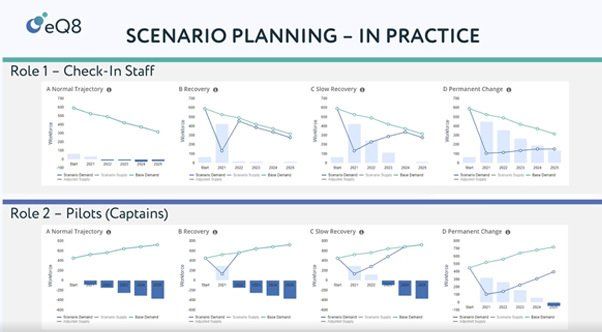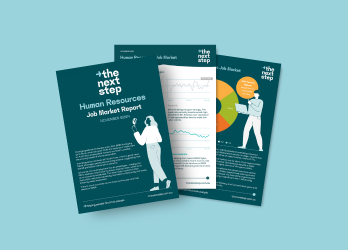Strategic Workforce Planning

Organisations are struggling to understand the size, shape and skills needed for their workforce of the future. In a recent Next Step webinar 81% of participants weren’t clear on size, shape and skillset needed by the business in the next 3 to 5-years. This is where strategic workforce planning can help.
While none of us has a crystal ball, there are approaches that can help provide clarity and consensus around the staffing needs of the business. Dynamic modelling can help predict future outcomes and provide a strategic approach to workforce planning. Read on to learn more.
The time is right for strategic workforce planning
The COVID crisis has led many organisations to make rash, short-term decisions to cut staff. A lack of strategy behind these decisions has the potential to cause future ‘chaos’ for the business, reducing access to people and skills needed in the future.
In 2020, for example, many HR departments dramatically reduced their Talent Acquisition teams. A year on, they are now seeking to rehire those very same roles at 10-15% price increase. Reducing costs in the short-term, has created a competitive disadvantage in the long-term.
Reactive measures are not only expensive in terms of wage costs, but can also cause irreparable damage to culture, corporate knowledge and your employment value proposition (EVP).
Future skills forecasting continues to be such a big gap for organisations, but few are aware that the bigger this gap, the harder it’s going to be for them to really achieve their purpose and strategy.
What is strategic workforce planning?
According to Alicia Roach, joint CEO of strategic workforce planning SAAS platform eQ8, the most fundamental question for any organisation is: “What is our purpose and what's it going to take to achieve it?”
Sounds simple, but there’s a complex recipe for employing the employing the right people, with the right mix of capabilities at the right place and time. Get the mix right and you have got a serious competitive advantage. Get it wrong, and the organisation suffers. “Your workforce is your key execution vehicle for delivering your purpose,” says eQ8 joint-CEO Chris Hare. “The mix of capability and capacity will be what makes or breaks you.”
All too often, however, businesses make short-term decisions, rehiring or firing staff and backfilling positions, without really considering whether workforce requirements align to long-term goals.
Staff profiling, analysis of trends and dynamic modelling can all help to achieve clarity. With an agreed vision of how the future can be achieved, the organisation can develop policies and strategies to BUY, BORROW or BUILD the workforce needed.
Dynamic scenario modelling
None of us can precisely predict the future, but by modelling different scenarios it’s possible to remove some of the guess-work.
Scenario planning can identify different workforce requirements depending on the shape of Australia’s COVID recovery. Proactive forecasting can examine workforce requirement if output needed to be doubled, tripled (or halved). It’s also possible to overlay transformation drivers within modelling. How will accelerating a technology initiative or delaying a project impact staffing needs for example?
With several possible pathways on the table, leadership teams can more easily identify the best plan to achieve the organisation’s purpose. While predictions aren’t guaranteed to pan out, they do give a clear indicator of potential trade-offs required and allow C-suite to discuss implications of different scenarios and achieve consensus on the option that best aligns with long-term strategic priorities.
“Modelling may show a shift in workforce requirements,” says Alicia Roach, “but imagine if you could let employees know well in advance and help them prepare for transition in a compassionate and honest way. Or even better, identify that they actually have 60-80% percent of the capability you need in a growing and emerging role and bring them on the upskilling, reskilling revolution with you.”

Dynamic scenario modelling by eQ8 provides clarity around future workforce requirements.
How to begin dynamic scenario modelling
If you haven’t developed strategic workforce plans before, it’s reasonable to feel daunted.
It’s best to start simple. Look at just a hand-full of major factors that might influence the future of the business, then consider two or three of your most critical skill sets connected to these factors. Often a major pain-point is a good place to begin.
Build-out some simple scenarios showing variations in these and use your modelling to help executives to have informed ‘trade-off’ conversations. The most successful planning requires input from finance, strategy and people and culture.
Over time you can build to greater levels of sophistication, modelling for different workforce segments, business initiatives, transformation projects and varying market demands.
For larger businesses, or those with more mature modelling requirements, analysis and planning tools such as eQ8, can help to produce complex dynamic modeling involving multiple real-time variables.
Making short-term decisions about workforce, without knowing whether they really align to long-term goals can cause serious damage. “The costs of not having the bandwidth to do this strategic planning is highly alienating your customers and disengaging employees,” says Chris Hare. “You need to ensure your organisation doesn't make short-term decisions that destroy your long-term viability.”
How can we help?
As a specialist Human Resources recruitment consultancy, The Next Step, can provide your business with the right HR leaders to help shape the skills, size and shape of your workforce for the future.
Whether you are looking to BUY, BORROW or BUILD the right capacity and capabilities in your organisation, please speak to your Next Step consultant for assistance.
Start planning now for the competitive advantage your organisation needs in the next 3-5 years.
Jo Skipper is Managing Director of The Next Step. She partners with the executive HR community to source exceptional talent across contract and permanent positions. Jo has a deep understanding of, and interest in, change management and total reward specialisations.
Author: Jo Skipper Date published : 30/08/2021



